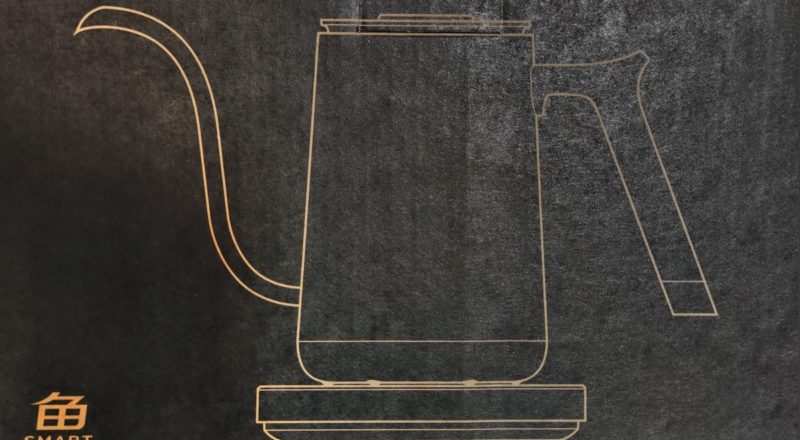For the longest time, my pouring setup was to first boil water with our normal electric kettle and then transfer it to a small gooseneck jug for better flow control. It’s worked well so far and I’ve managed to get good tasting cups, especially after I upgraded my grinder.


But it’s been bugging me that I don’t really know what temperature I’m actually brewing at, and I was considering getting a thermometer just to check. And then I thought about it some more and decided to just go all the way and finally get a temperature-controlled gooseneck kettle.
Everyone (and their dog) seems to own the Fellow Stagg EKG, and while I’ll admit that it looks really good and seems to get the job done, I didn’t feel like spending quite so much on a kettle. So I did more digging around and found the Timemore Fish Smart kettle, which was half the price and did essentially the same thing.
The price variance from different online shops was quite wide, and the best prices were offered by shops that shipped from China. Even though that meant that it would take slightly longer to ship and come with a China plug, the voltage is Singapore-compatible and I’d just have to use a multi-adapter, which I already happen to have in my drawer.
As usual, it arrived double-boxed with a plain brown outer one to absorb all the beating during shipping, and the actual inner one with the proper branding and graphics. I bought the 600ml (vs the 900ml) version and it was compact and just the right size for my daily use.


The thermometer was located on the base, just beside the spout outflow point, and the temperature control is done via a Strix thermostat. There were no protruding buttons on the base and all controls are based on touch, including the intuitive slider for setting temperatures.


There was a simple user manual included in the box, Chinese on one side and English on the other, but it was simple enough to use without having to read the manual. But as usual, I’m keeping a copy here for ease of future reference.




After rinsing and doing a couple rounds of boiling, I put the kettle to work. We recently paid a visit to Tiong Hoe Specialty Coffee in Stirling Road and bought a couple of bags of freshly-roasted single-origin beans, and I opened the Costa Rica Don Alfonso to sort of keep bean origin the same as my recent grinder calibration run.
Since it came in a 200g bag, I brought down my usual 30g dose to 25g to avoid orphan beans and achieve the ideal “no bean left behind” outcome. I’ve noticed that local roasters usually sell their freshly-roasted beans in 250g or 200g bags, so moving forward, I’ll be changing my daily dosage to 25g.

Based on what I recently read in a coffee book, “The ideal temperatures for brewing are between 91°C and 96°C, and the closer to the higher figure, the better”, so I started with 96°C and tried all the way down to 88°C, in decrements of 2°C, over the next few mornings.
The results weren’t what I was expecting, given that I had kept the grind size, pour technique and coffee-to-water ratio the same as last time. The only other changes were: (i) temperature (88-96°C vs don’t-know-what), (ii) dosage (25g vs 30g) and (iii) beans (Tiong Hoe vs Mt Whitney).
I wanted to avoid orphan beans for the Tiong Hoe, so I didn’t change (ii) but I had another bag of Mt Whitney Costa Rica on hand and opened it so that I could eliminate variable (iii). The results were similar across both beans — generally weaker body and flat tasting, an indication of under-extraction.

It was definitely more convenient using the Timemore kettle, so I’m not going back to my old big kettle + small gooseneck jug setup. Also, using a 25g dosage is more practical given that I’m planning to start trying beans from different local roasters, so I’m planning to stick with that as well.
So, to try and re-capture the taste of my earlier best cup using the latest equipment, I’m going to use the newly opened Mt Whitney Costa Rica and start tweaking grind size (again). Maybe also reduce the coffee-to-water ratio, as a proxy to increasing dosage, since the ideal Tetsu 4-6 ratio is 1:15 (25g coffee x 375g water) vs the 1:16.8 (25g coffee x 420g water) I’m currently using.
It’s been quite fascinating to see how small changes in different variables have resulted in very diverse tasting cups of coffee. I still haven’t quite achieved that really good cup that I’d be happy to drink every single morning yet, but it feels like I’m coming close. And even though it seems like the classic case of two-steps-forward-one-step-back with my recent equipment upgrades, I’m definitely making forward progress.
Note: This post contains affiliate links. If you use these links to buy something, I may earn a commission. Thanks.
